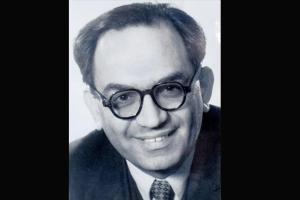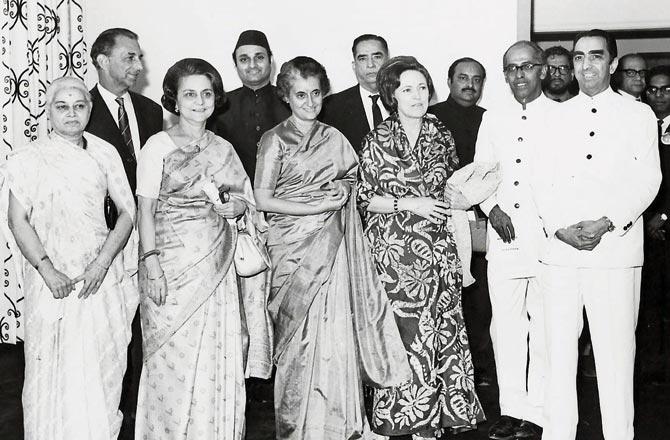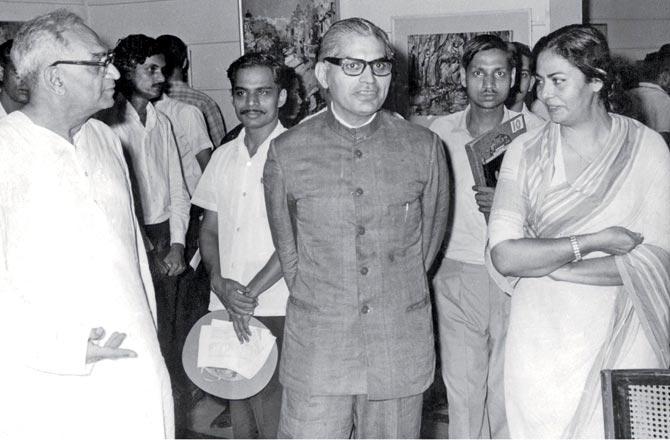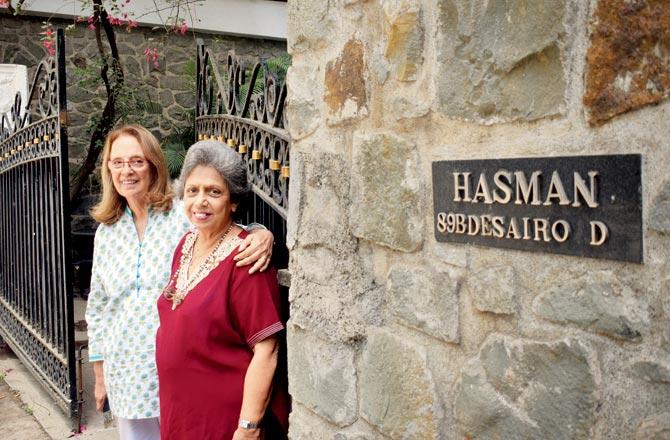Soli Batlivala, family friend of art connoisseur Madhuriben Desai, galvanised 1950s-60s Bombay's cultural scene at the Bhulabhai Desai Memorial Institute and Jehangir Art Gallery. A tribute on the eve of his May 19 birth anniversary

Soli Batlivala
 It was a scene out of a film. The young patriot supporting the Quit India struggle heard the police knock on the door of his Parel home. Though no stranger to jail, alerted by his mother Bachoobai, he bolted from a back door and jumped on the tiled roof. Unable to share his son and wife's sympathies, red faced before the officers was Dr Shiavax Batlivala, a physician and Mayor of Bombay under the British.
It was a scene out of a film. The young patriot supporting the Quit India struggle heard the police knock on the door of his Parel home. Though no stranger to jail, alerted by his mother Bachoobai, he bolted from a back door and jumped on the tiled roof. Unable to share his son and wife's sympathies, red faced before the officers was Dr Shiavax Batlivala, a physician and Mayor of Bombay under the British.
ADVERTISEMENT
Soli Shiavax Batlivala, diehard Congressman turned card-carrying communist, handled his duties as cultural czar with the ardour he reserved for politics. At the Bhulabhai Desai Memorial Institute, Soli Mama, as everyone knew him, propagated the dynamism and generosity of the family of Bhulabhai Desai, whose vision changed the way freshly independent India engaged with the arts.
![]()
In early Congressman avatar
Bhulabhai Desai Road, where the eponymous institute rose, honours the jurist dedicating his immense wealth to this crucible of culture. Batlivala was personal assistant to Bhulabhai's son Dhirajlal (Dhiru), accompanying him to Berne when Dhirubhai was appointed India's ambassador to Switzerland.
Bombay's artistic fervour came to be distilled at 89 Warden Road (before the street salaamed Bhulabhai Desai), the address of the institute opposite today's Tata Garden. It was the brainchild of Madhuriben, Dhirubhai's art lover wife who assigned Batlivala charge as catalytic trustee-manager to run this unique hub, unlike any previous prototype. The estate comprised two bungalows set at an angle. Madhuriben lived in road-fronting Hasman, now the Dubash residence. Another ground-plus-one Art Deco structure was the institute, vibrant with activity from 10 in the morning to 11 at night.

At the 1969 opening of the NCPA in Akash Ganga building: Madhuriben Desai, JRD and Thelma Tata, Minister for Education and Culture, Karan Singh, Indira Gandhi, Betty Bhabha, NCPA Executive Director, VK Narayana Menon, Jamshed Bhabha and (behind, extreme right) Subhas Chandran, on special duty in Narayana Menon’s office. Pic courtesy: NCPA
"Madhuri Masi was a connoisseur and fine photographer herself," says Pheroza Godrej whose parents were the Desais' family friends. "Everything at Hasman was aesthetic, selected with taste and care. Even a banister made a lyrical statement. Solibhai sat, not in a closed office cabin but a simple glass enclosure." Godrej was present at a dinner party at which Madhuriben and JRD Tata planned to convert the abandoned landfill across Hasman into Tata Garden.
Batlivala's nieces, Zarine Khambatta and Freny Olbrich — whose Soli Mama he really was, their mother Sheroo's brother — piece together their remarkable uncle's life. "Mama met leaders like Gandhiji, Nehru and Vijaya Lakshmi Pandit, guests at Hasman on their visits to the city," says Khambatta. Olbrich writes from Scotland: "A man of unflinching integrity, Soli Mama left the Congress because after Independence it conflicted with ideals he would not abandon."

Soli Batlivala, Rafique Zakaria and Usha Rajbans Khanna at Samovar which opened at Jehangir Art Gallery in 1964 thanks to Batlivala. Pic courtesy: The making of SAMOVAR: Usha R Khanna
What principles, essentially, compelled Batlivala to shift his staunch stance? "He was a beautiful Marxist," says design academician Mahendra Thakkar. "Indians viewed this 'ism' as an extension of democratic socialism. The 1950s were wonderful. Everyone rallied around an ideal of national integration which Solibhai helped put into practice. The country wasn't cut off from a history of art — in Bombay the Opera House and Laxmi Bagh in Girgaon laid the groundwork for such awareness. That underwent a disconnect under the British. But Solibhai walked the talk, ensuring the Bhulabhai represented classicism and modernism in the Indian arts."
A section of painters believes otherwise. They claim that Batlivala promoted personal favourites and preferred conventional to contemporary art. In a lighter aside Thakkar smiles, narrating how, as a toddler, he happily drew with a 5-paise piece of chalk on the pavement outside, while his mother Sharda attended Hindustani classical vocal classes at the institute. Sharda Thakkar went on to form the reputed Sangeet Shala Vrind music group.

Pheroza Godrej, whose parents were close to Madhuriben Desai, with Soli Batlivala's niece Zarine Khambatta, outside Hasman Bungalow on Bhulabhai Desai Road
Dance historian Dr Sunil Kothari notes, "In the early 1950s, we greenhorns wanting to savour dance, music, theatre or art, and meet their exponents, just approached Soli Mama at Hasman." Captivated, they watched the Bharatanatyam brilliance of Chinna Sharada, disciple of Rukmini Devi from Kalakshetra, and a rare performance of Kathak queen Roshan Kumari, among other vibrant events.
A certain effervescence covered every conceivable art practice. Piloo Pochkhanawala sculpted undisturbed for hours. When he was not bowing for namaaz while sketching posters for a production of Medea, MF Husain begged Prafulla Dahanukar to continue with her habit of singing as she painted — for his tuneful inspiration. Like them, Gaitonde, Raza, Dashrath Patel and Tyeb Mehta (whose wife Sakina's verandah shop stocked rare art books) were allotted balcony cubicles or studios for a rupee per day, thin-partitioned, unlocked spaces shared within mutually agreed on timings.
The institute spelt infectious energy and synergy. Ebrahim Alkazi staged Greek tragedies on the terrace which was his drama troupe's theatre. One experiment saw him spotlight Husain's rectangular canvas, The Voice. Alkazi directed silk-toned Zul Vellani reciting a poem by that title to piano accompaniment and Austrian emigre critic Rudy Von Leyden discussed the artwork.
A marvellous nucleus of pursuits and passions, the institute sprang spirited exchanges between genres. Gaitonde asserted, "A writer must know what painting is, what music is, not only Indian music but world music. A dancer must know what theatre is." From his fixed spot on a bench the reticent painter gazed long at the interplay of sky and sea facing the institute, echoed in his stark frames.
Artists took liberties with each other. Ara, for instance, chided Ravi Shankar, bothered by the sitarist's dealings with his first wife, surbahar doyenne Annapurna Devi.
Introduced to Ravi Shankar's Kinnara school of music, the legendary violinist Yehudi Menuhin declared Indian music challenged his intellect. French films screened provided audiences an initial whiff of international cinema and Rati Mehta was renowned for piano lessons on a Bosendorfer.
Writer and literature professor extraordinaire, Nisha da Cunha, offers a detailed memory of the institute garden. "On a sloping, desolate section of the lawn, which could be a bit unkempt, I directed Uncle Vanya. We were helped to create the mood with this readymade prop of a shed, the backdrop against which Chekhov's characters could talk."
Some stalwarts treasure institute heirlooms. Pointing to a writing table in her living room, Vijaya Mehta, whose Rangayan laboratory launched experimental Marathi theatre, recalls, "When that creative nest, giving us such freedom and joy, could no longer survive, I got two gifts from Solibhai. First, he housed Rangayan's records in the basement till they found a home. The second was three pieces from his office: a grandfather clock, a wooden sculpture and this desk which was Bhulabhai's very own."
With the bungalow auctioned in the 1960s, the institute shifted to the first floor of Akash Ganga building on the same property. Madhuriben's grand-nephew, Samveg Lalbhai in Ahmedabad, vividly recalls its 99-seater auditorium. Outside, the bright blue carpeted hall had a grand chandelier and 26 stained glass panels embellished with Indian dance poses.
A level above the institute's new quarters, the National Centre for the Performing Arts was born in 1969, Dr VK Narayana Menon its Executive Director. Appreciative of the cultural vision JRD Tata nurtured for the city, Madhuriben accepted rent of a rupee a year for five years of hosting the NCPA before it shifted to Nariman Point. Subhas Chandran, on special duty in Dr Menon's office, says, "He and I were from Delhi, both new to Bombay. I grew close to Soli Bhai, admiring how he had a solution for everything and was ready to discuss any issue."
The power behind the Bhulabhai revelled in an important parallel role. From 1963, Batlivala supervised administration, licensing and bookings at Jehangir Art Gallery as its honorary secretary. "A pillar of the art community, he was a godfather to me," says Karthiyani Menon, the gallery's long-time secretary. "Mama spent mornings at Jehangir. He was plain-speaking to a fault. Doing exactly as he felt often made him quite controversial." It was Batlivala's critical decision to lease the first floor to Kekoo Gandhy for Gallery Chemould, a pioneering sponsor facility that spared grateful artists the expense of printing catalogues or holding receptions.
From Devieka Bhojwani I hear a retelling of Batlivala's pivotal part in opening Bombay's beloved little corridor cafe at the Jehangir. (Are we — who romanced, wrote and lunched there — never tired of Samovar stories?) "Solibhai changed our lives forever," Bhojwani says. "My mother, Usha Rajbans Khanna, the niece of Balraj and Bhisham Sahni, came from culture but considered herself an ordinary housewife bringing up three kids in faraway Juhu."
It was 1964, a few years after Khanna returned from France where her director husband's documentary, Gotama the Buddha, won the Jury Prize in Cannes. Bumping into Batlivala, dressed in usual white kurta-lehnga, after an exhibition, Khanna mentioned she missed the Left Bank vibe she'd experienced at atmospheric cafes and bars. Wistfully she said, "We need a place for artists relaxing over tea." The prompt response was, "Why don't you start it?" Batlivala coaxed her to show up with a stove, cups and saucers from her kitchen. "Mum packed extra quantities of the daily snack she cooked for us to take to school, typically Punjabi kheema rolls and samosas," Bhojwani says.
Back at Bhulabhai, the chham-chham tinkle of ghungroos was a pervasive sound. Dance was a well-represented discipline, exponents from Sonal Mansingh to Waheeda Rehman and Hema Malini rehearsing here with their gurus. Acknowledging the impact Batlivala had on his followers till June 1986 when he died, Sunil Kothari says, "The contribution of Soli Batlivala and Bhulabhai Institute will go down in the history of the art world of Bombay in golden letters."
Author-publisher Meher Marfatia writes fortnightly on everything that makes her love Mumbai and adore Bombay. You can reach her at mehermarfatia@gmail.com/www.mehermarfatia.com
Catch up on all the latest Crime, National, International and Hatke news here. Also download the new mid-day Android and iOS apps to get latest updates
 Subscribe today by clicking the link and stay updated with the latest news!" Click here!
Subscribe today by clicking the link and stay updated with the latest news!" Click here!






